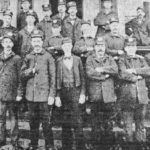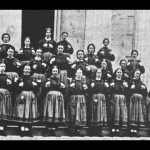
Attendants at Central Islip Psychiatric Hospital, 1910, courtesy Minnesota Governor's Council on Developmental Disabilities
Insane asylums were important to local economies. Local men were needed for construction work or repairs, and businesses could count on meeting at least some of an asylum’s supply needs. Perhaps more importantly, insane asylums provided steady work for locals. From 1900 to 1907, the Canton Asylum for Insane Indians spent $54,896.78 on maintenance, some of which found its way into local pockets. It spent almost as much on wages, though–which was probably far more important. The payroll went from a bare $2,080 at the end of 1902 to $11,340 by 1907.
The first salary list included: a superintendent and assistant superintendent, a financial clerk, an attendant, three laborers, and a night watch (8 total). By 1909, the list included: a superintendent and assistant superintendent, clerk, matron, seamstress, laundress, cook, dining room girl, engineer, two male and two female attendants, three laborers, a night watchman, and a laborer (18 total). As buildings and the patient population went up, the asylum pumped more and more money into Canton and the surrounding area. It’s little wonder that the townspeople had a soft spot in their hearts for the facility and considered it a valuable resource.

Graduation Class of Nurses at Utica State Insane Asylum, 1899, courtesy Minnesota Governor's Council on Developmental Disabilities

Woman Attendants With Dumb Bells at the Pennsylvania Hospital for the Insane, early 1860s, courtesy Minnesota Governor's Council on Developmental Disabilities
______________________________________________________________________________________